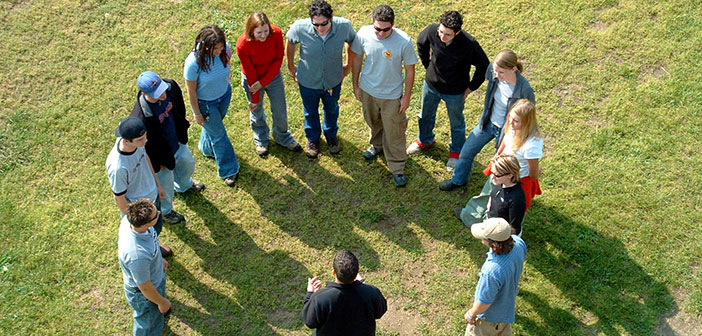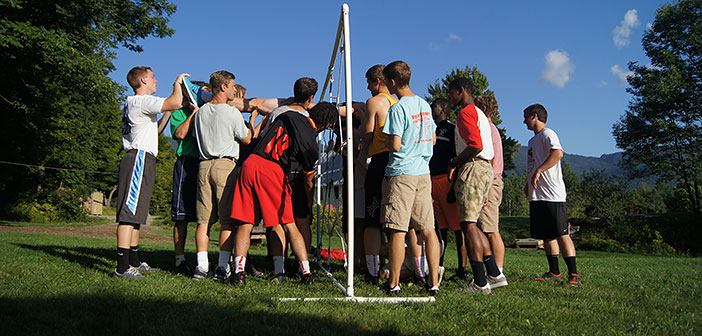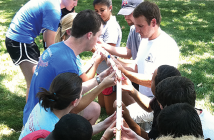Can a pay-to-play adventure park double as an experiential education facility? The evolution of the adventure-park concept from the experiential education business in the last couple of decades has created two distinct paths: one, a commercial park for recreation, thrills, and amusement, the other a program to achieve specific educational, developmental, or therapeutic objectives, team-building being preeminent among them.
The first finds its audience primarily in the general public, just out to have a good time, while the second finds its audience in organizations—schools, corporations, governmental bodies, etc. And both, if well designed and managed, can produce healthy profits.
This bifurcation, however, raises some fundamental questions. Which approach works best—or most profitably—at a particular park? Can a single park serve both purposes? And if a park owner or manager chooses to go after both markets, what are the keys to pulling it off successfully?
On the Ropes
All modern adventure parks can trace their heritage back to the ropes courses that gained popularity in the 1980s. And ropes courses can trace a familial link to military training courses with a history that stretches across millennia.
Traditional ropes courses, both high and low, were conceived with developmental goals in mind. The idea was to help participants overcome fears, learn to work together as a team, and grasp what it means to rely on the help of another person (through human belay).
Ropes courses and their variations, of course, remain an integral component in the overall adventure-park picture. But as new elements have come into play—zip lines, canopy tours, suspension bridges, and others designed more for individual fun than teambuilding and mutual reliance—and as new safety devices such as auto-belays and automatic braking systems have been introduced, the idea of simply creating a park for entertainment (fun for the whole family!) has blossomed. In many ways, it’s simpler. No need to tailor programs to meet the developmental objectives of a group. And the potential market is larger. Just about anyone who falls within a park’s height and weight criteria can buy a ticket, put on a harness, get a brief instructional intro, and happily go on their way.
But the growth of pay-to-play parks won’t squelch the education/development concept. A very healthy market still exists for that approach, too. So back to the original question: Can a park do both, recreation and education?
Yes—some are doing so quite effectively. While pay-to-play and experiential programs often feature somewhat different physical structures and aerial elements, what matters most is how those elements are used, not the differences between them.
In fact, says Scott Chreist, CEO of Adventura in Washington state, in the realm of experiential development, “You don’t really need a course. A good course just augments what you do.” A developmental program may incorporate ground-based activities, a low-ropes course, a high-ropes course, or adventure-park elements. There is no single design model to cover all bases, since program objectives can vary so widely.

Team members celebrate a triumph at Adventura, where facilitators design programs based on customer needs and the park’s facilities.
Leslie Sohl, director of training and operations for Bonsai Design, agrees. A developmental program, she says, depends not on the structures or their design per se, but on “how you use the structures to achieve specific goals through a specific process.”
Two in One
The main thing that makes a developmental program work is the expertise of facilitators in creating and shaping unique programs that might be directed toward disparate objectives. That’s why for developmental courses, says Sohl, “Invest in staff, not necessarily structures. You don’t put money into your structures, you put money into your team.”
Adventura has chosen, successfully, to address both concepts. Chreist is the former director of ropes courses for Outward Bound, so he has extensive knowledge on the experiential education side of the ledger. He notes that the two concepts have not (or not yet) dovetailed into a single model; at Adventura, the recreational adventure park and corporate team-building business remain, with some overlap, separate.
Some layouts, though, lend themselves to multiple uses more than others. Sohl says that while a commercial park will typically feature larger structures and larger spaces, a developmental course should be more contained, to promote more group interaction. A hub-and spoke layout, adds Chreist, might not work well, because participants become too dispersed.
On the other hand, variety can bring its own advantages. For example, Chreist says groups at Adventura may well do group-oriented teambuilding activities in the morning, then have fun playing in the adventure park in the afternoon.
Focus on Outcomes
Mike Smith, president of Arbortrek, agrees that the elements, obstacles, or activities in any developmental course are less important than “the approach you take.” That means determining in advance the desired outcomes or objectives of any particular group, and then custom-designing a program and context within which those objectives can best be met.

Facilitator leads a session at Arbortrek.
For an adventure park to offer a viable experiential program, says Smith, it’s important to create “activities that provide opportunities for individuals to support one another.” The idea is to set up “a context to create a sense of interdependence.”
Traditionally, a big part of the experiential process was relying on a teammate to mitigate risk, especially in belaying on ropes courses. The automatic belays and other safety devices now used at adventure parks have essentially turned real risk into perceived risk. Still, activities can be built on the premise of teamwork—say, two teammates stabilizing a wobbly rope bridge while another crosses. The challenges used to achieve a group’s objectives are different, even as the goal remains the same.
In addition, the ability and motivation of participants to pursue those objectives can vary widely. Differences in physical fitness, confidence, psychological barriers, and the cognitive makeup of group members all come into play. As Smith points out, there is no single way to approach school groups, since developing a program for fourth graders is an entirely different ballgame than developing a program for high schoolers. For a corporate group, inter-office rivalries or perhaps participants suffering from specific psychological barriers need to be accounted for.
Bonding Vs. Teambuilding
Smith acknowledges that “it is a lot harder to sell educational programs” than simple recreation. The least complicated approach to group business, he says, is to lead a group through a park’s pay-to-play elements mainly just to have fun and blow off steam. That can produce the positive outcome of team bonding—“just being outside together,” as Sohl puts it—which can be a worthy objective, and it fits within normal operations of a pay-to-play park.
Facilitated teambuilding is a much more involved process. It takes more time to craft a program, and an investment in facilitators who can do just that. Facilitators, says Chreist, need to be involved in a much broader capacity, including in sales. An educated, informed, and creative staff is the key to a quality developmental program, and thus a successful sale “depends on the relationship—the trust and authenticity—you form at the start,” he says.

A teambuilding group at Arbortrek works through a spider wall activity.
Once that relationship has been established, a facilitator becomes a soup-to-nuts guide throughout the entire process: helping to establish goals, designing a program to meet those goals, taking a leadership role throughout the execution of the program, and structuring post-event review and assessment by the participants. Larger companies often employ a third-party consultant/planner to help with the process.
Adventura’s investment in this process is embodied in a widely differing pay structure. Certified facilitators with an appropriate educational background can earn $150 an hour, while recreational-park guides earn $22 an hour.
So why should you consider offering developmental programs? For one thing, well-conceived programs often have a high repeat-business rate. Chreist says that at Adventura, the recreational park has roughly a 25 percent return rate, while the developmental side has closer to a 65 percent return rate.
Once that trust and authenticity has been established, companies, schools, and other organizations are likely to come back—say, the executive committee one year, the sales staff the next. Or the fifth-grade class for one session, sixth graders for another.
The initial marketing outreach can be a challenge. Sohl suggests canvassing the chamber of commerce and local businesses and doing research to find potential local and regional corporate business. But once a connection has been established, it often pans out as far more than just a one-shot deal.
So to answer the question posed at the beginning of this article: Not all adventure parks can address both commercial and developmental approaches. But as Adventura and others have demonstrated, the two can be coordinated to supplement one another.




